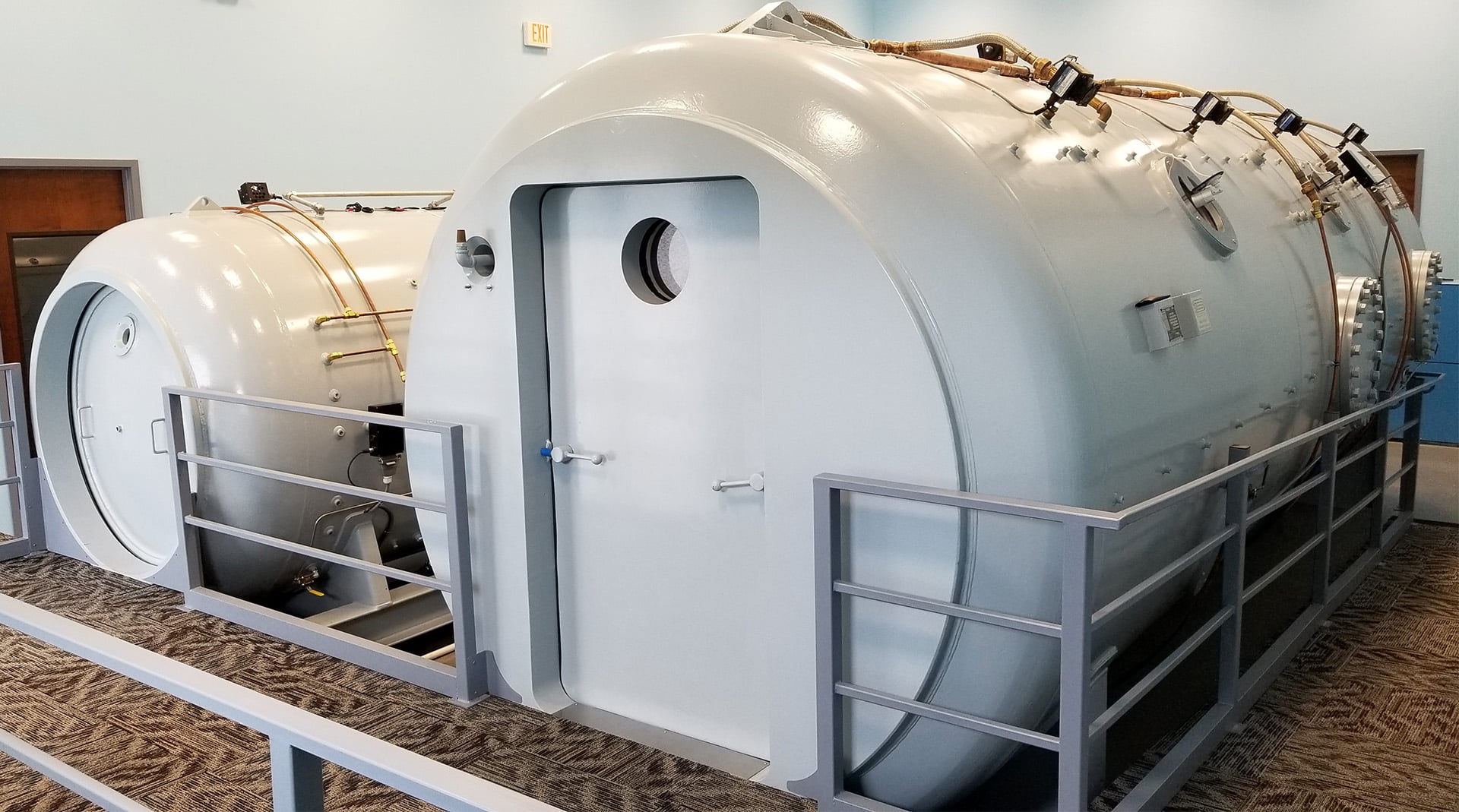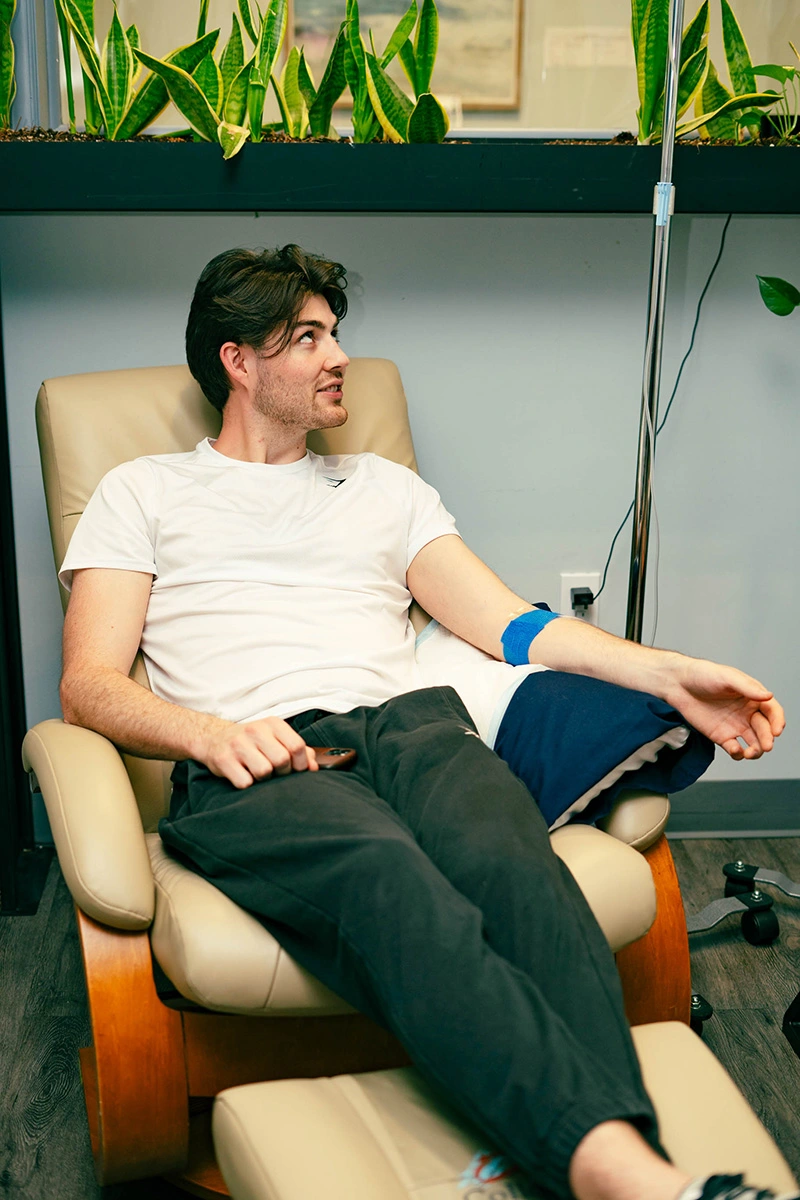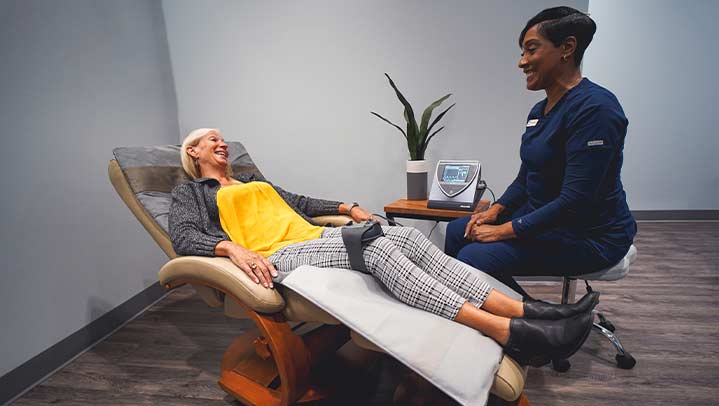Osteoarthritis
Osteoarthritis is the most common form of arthritis, affecting over 32.5 million adults in the United States alone. It occurs when the protective cartilage that cushions the ends of bones within a joint gradually breaks down, leading to pain, stiffness, swelling, and reduced mobility. While commonly associated with aging, osteoarthritis is not just a result of wear and tear—it is influenced by a combination of biological, mechanical, and environmental factors that disrupt joint health over time.
At Extivita, we believe integrative medicine plays a critical role in supporting musculoskeletal health and addressing complex conditions like Osteoarthritis. Our therapies aim to target contributing factors such as inflammation, oxidative stress, impaired circulation, and poor nutrient absorption—factors that can compromise joint integrity
Understanding Osteoarthritis
In most cases, osteoarthritis develops gradually due to a combination of internal and external factors. One key contributor is chronic inflammation, which can wear down cartilage and irritate the tissues that support your joints. Another is oxidative stress, which happens when the body has too many free radicals—unstable molecules that are naturally produced through normal processes like metabolism, or introduced through environmental exposures such as pollution or poor diet. Free radicals are harmful because they’re missing an electron, so they try to stabilize themselves by stealing electrons from nearby cells, including those in your joints. This can weaken cartilage, slow healing, and contribute to long-term joint damage.
Poor circulation also plays a role by limiting the oxygen and nutrients delivered to joint tissues, making it harder for the body to maintain and repair them. Additionally, many people with osteoarthritis have low levels of important nutrients like vitamin C, magnesium, and zinc, which are essential for reducing inflammation and supporting tissue repair. Mechanical stress from repetitive movement, past injuries, or excess body weight can further accelerate wear and tear on the joints.
Extivita Therapies for Osteoarthritis

Hyperbaric Oxygen Therapy

Nutritional IV Therapy

Pulsed Electromagnetic Field Therapy (PEMF)

Infrared Sauna
Hyperbaric Oxygen Therapy (HBOT) for Osteoarthritis
Hyperbaric Oxygen Therapy (HBOT) involves breathing 100% medical-grade oxygen in a pressurized chamber—typically at 2.0 atmospheres absolute (ATA). Under these conditions, your blood plasma absorbs and delivers significantly more oxygen throughout the body, especially to areas with poor circulation, inflammation, or degenerative tissue. For individuals with osteoarthritis, this boost in oxygen helps reduce joint inflammation, stimulate tissue repair, and enhance the delivery of nutrients necessary for joint health. HBOT supports the body’s natural healing mechanisms, making it a powerful tool for managing pain, improving mobility, and slowing joint degeneration.
How HBOT Supports Joint Health in Osteoarthritis
Stimulates Stem Cell Activation and Tissue Regeneration
HBOT increases the body’s production and release of stem cells from the bone marrow into the bloodstream. These stem cells help repair damaged cartilage and other joint tissues affected by osteoarthritis. By encouraging cellular regeneration, HBOT supports long-term joint recovery and may slow down the progression of joint deterioration.

Reduces Joint Inflammation and Pain
Ongoing inflammation plays a key role in the development and progression of osteoarthritis, often driving joint pain and stiffness. HBOT has been shown to reduce pro-inflammatory markers in the body, helping to ease inflammation within affected joints. By creating a more balanced and supportive environment for healing, HBOT can promote tissue repair and provide meaningful, long-lasting relief from pain.
Improves Circulation in Affected Joints
Cartilage and surrounding joint tissues have limited blood supply, which restricts oxygen and nutrient delivery. HBOT overcomes this by flooding tissues with oxygen-rich plasma, even in poorly perfused areas. This improves cellular metabolism, waste removal, and supports joint tissue maintenance.

Improves Mobility by Protecting Joint Tissue
Osteoarthritis often limits movement due to cartilage damage and joint stiffness. HBOT supports joint health by reducing inflammation and enhancing oxygen delivery to damaged tissues, which helps protect cartilage and surrounding structures. As joint function improves and pain decreases, many individuals experience greater flexibility and ease of movement—leading to better mobility and quality of life
Accelerates Healing After Joint Injury or Surgery
For individuals undergoing joint replacement or recovering from injury, HBOT speeds up the healing process by improving oxygen delivery to surgical or damaged sites. Faster healing helps reduce downtime, lowers the risk of complications, and enhances rehabilitation outcomes.
Slows the Progression of Osteoarthritis
HBOT delivers concentrated oxygen to joint tissues, including areas with poor circulation where healing is typically limited. This increased oxygen availability stimulates chondrocyte activity—the specialized cells responsible for maintaining and repairing cartilage. By enhancing chondrocyte function, reducing chronic inflammation, and supporting cellular regeneration, HBOT helps create a healthier joint environment. Over time, this may slow cartilage breakdown and delay the progression of osteoarthritis.
IV Therapy for Osteoarthritis
Nutritional IV Therapy delivers a concentrated blend of essential vitamins, minerals, antioxidants, and amino acids directly into the bloodstream, bypassing the digestive system for superior absorption and faster therapeutic effect. For individuals with osteoarthritis, this therapy plays a supportive role in reducing inflammation, replenishing joint-supportive nutrients, and enhancing the body’s natural healing processes—key components in managing chronic joint pain and preserving long-term mobility.
How IV Therapy Supports Joint Health in Osteoarthritis
Replenishes Nutrient Deficiencies
With osteoarthritis, the body’s demand for joint-repairing nutrients like vitamin C, magnesium, and B-complex vitamins often exceeds what can be absorbed through diet alone—especially in older adults. IV Therapy restores these nutrients directly into the bloodstream, where they support collagen synthesis, reduce oxidative stress, and improve energy production needed for cellular repair within joint tissues.

Promotes Detoxification
Chronic inflammation and oxidative stress contribute to cartilage breakdown and joint degeneration. Antioxidants such as glutathione, delivered intravenously, enhance the body’s detoxification pathways by supporting liver function and neutralizing free radicals. This helps reduce inflammation throughout the body, creating a more favorable environment for tissue healing and improved joint function.

Key IV Recommendations for Osteoarthritis
Myers’ Cocktail IV
Components: B-complex vitamins, Vitamin C, Magnesium, and Calcium
- B-complex vitamins support energy metabolism and nerve function, aiding in the repair of joint tissues and reducing fatigue often associated with chronic pain.
- Vitamin C is essential for collagen synthesis and acts as a powerful antioxidant, helping protect cartilage from oxidative damage.
- Magnesium promotes muscle relaxation and reduces inflammation, easing joint stiffness and improving mobility in individuals with osteoarthritis.
Glutathione IV
Components: Reduced Glutathione
- Glutathione helps neutralize free radicals and reduce oxidative stress, a key driver of cartilage breakdown in osteoarthritis.
- It supports detoxification and protects cells involved in joint repair, contributing to improved tissue recovery and reduced inflammation.
NAD+ Trio IV
Components: Myers’ Cocktail, Reduced Glutathione, NAD+
- NAD+ supports mitochondrial function and cellular energy production, both of which are critical for joint cell repair and managing fatigue in chronic joint conditions.
- This IV aids in reducing systemic inflammation, promoting tissue regeneration, and supporting resilience against the progression of osteoarthritis.
Pulsed Electromagnetic Field (PEMF) for Osteoarthritis
PEMF (Pulsed Electromagnetic Field) Therapy uses low-frequency, pulsing electromagnetic waves to stimulate cellular repair and reduce inflammation—key factors in managing osteoarthritis. These gentle waves help recharge damaged or low-functioning cells, improving their ability to heal and respond to stress. By enhancing circulation, boosting cellular energy (ATP), and regulating nerve signaling, PEMF supports joint recovery, reduces pain, and improves mobility without the use of drugs or invasive procedures.
How PEMF Therapy Supports Osteoarthritis

Reduces Joint Pain and Inflammation
PEMF Therapy helps relieve chronic joint pain by calming inflammation and improving blood flow to affected areas. It also modulates pain signals in the nervous system, offering natural, non-invasive relief for individuals managing osteoarthritis. Over time, this can lead to decreased reliance on medications and greater daily comfort.
Enhances Cellular Energy and Tissue Repair
By stimulating the mitochondria—the energy-producing centers of cells—PEMF boosts ATP production and promotes the repair of damaged joint tissues. This supports cartilage health and slows joint degeneration over time. Regular sessions can accelerate healing and improve long-term joint function.

Reduces Stiffness and Improves Flexibility
Osteoarthritis often leads to stiffness that limits daily movement. PEMF Therapy improves circulation and relaxes surrounding tissues, helping to reduce joint stiffness and increase overall flexibility and ease of motion. Patients often report greater ease with walking, standing, and performing everyday tasks after consistent treatment.
Infrared Sauna for Osteoarthritis
Infrared Sauna Therapy uses infrared light to gently heat the body directly, rather than heating the air around you like traditional saunas. This creates a more comfortable experience at lower temperatures—typically between 120°F and 140°F (49°C–60°C)—making it ideal for individuals with chronic joint conditions. The deep, penetrating heat reaches muscles and joints, promoting relaxation, improved circulation, and tissue recovery. For those with osteoarthritis, this therapy offers a non-invasive way to ease symptoms and support long-term joint health.
How Infrared Sauna Supports Osteoarthritis
Relieves Joint Pain and Stiffness
The deep heat from infrared light penetrates into the joints, increasing blood flow and relaxing surrounding muscles. This helps reduce stiffness and ease joint pain, making movement more comfortable for individuals with osteoarthritis. Many users report feeling looser and more mobile after each session.
Improves Circulation to Support Joint Repair
Enhanced circulation from infrared therapy delivers more oxygen and nutrients to inflamed or damaged joint tissues. Better blood flow supports natural healing, reduces swelling, and aids in flushing out inflammatory byproducts that contribute to pain and degeneration.

Reduces Inflammation and Supports Detoxification
Chronic inflammation plays a key role in osteoarthritis progression. Infrared heat promotes mild sweating, which helps the body eliminate toxins and inflammatory waste products. Over time, this may lower the inflammatory load on joints, supporting a more balanced internal environment for healing.
Read to Begin Your Journey to Recovery?
Schedule a free Personalized Wellness Visit to explore a custom plan designed to reduce joint pain, improve mobility, and support long-term joint health through targeted, non-invasive therapies.
Schedule Your Free Wellness Visit →
References:
- “Osteoarthritis.” Centers for Disease Control and Prevention, Centers for Disease Control and Prevention, 12 June 2023, archive.cdc.gov/www_cdc_gov/arthritis/types/osteoarthritis.htm.
- Wang, Jianjian, et al. “Mechanism of hyperbaric oxygen therapy downregulating H-type angiogenesis in subchondral bone of knee osteoarthritis through the PHD2/hif-1α pathway.” Journal of Orthopaedic Surgery and Research, vol. 20, no. 1, 22 Jan. 2025, https://doi.org/10.1186/s13018-025-05514-8.
- Wilson, Hilary D., et al. “Hyperbaric oxygen treatment is comparable to acetylsalicylic acid treatment in an animal model of arthritis.” The Journal of Pain, vol. 8, no. 12, Dec. 2007, pp. 924–930, https://doi.org/10.1016/j.jpain.2007.06.005.
- Melcher, Carolin, et al. “Effect of hyperbaric oxygen on proliferation and gene expression of human chondrocytes: An in vitro study.” Cartilage, vol. 10, no. 4, 27 Mar. 2018, pp. 459–466, https://doi.org/10.1177/1947603518764281.
- Thom, Stephen R., et al. “Stem cell mobilization by Hyperbaric Oxygen.” American Journal of Physiology-Heart and Circulatory Physiology, vol. 290, no. 4, 1 Apr. 2006, https://doi.org/10.1152/ajpheart.00888.2005.
- Woo, Jinhee, et al. “Effects of hyperbaric oxygen therapy on inflammation, oxidative/antioxidant balance, and muscle damage after acute exercise in normobaric, normoxic and hypobaric, hypoxic environments: A pilot study.” International Journal of Environmental Research and Public Health, vol. 17, no. 20, 10 Oct. 2020, p. 7377, https://doi.org/10.3390/ijerph17207377.
- Dunlap, Burton, et al. “Vitamin C supplementation for the treatment of osteoarthritis: Perspectives on the past, present, and future.” Therapeutic Advances in Chronic Disease, vol. 12, 20 Jan. 2021, https://doi.org/10.1177/20406223211047026.
- Fang, Zhaoyi, et al. “Vitamin B6 alleviates osteoarthritis by suppressing inflammation and apoptosis.” BMC Musculoskeletal Disorders, vol. 25, no. 1, 6 June 2024, https://doi.org/10.1186/s12891-024-07530-x.
- Kuang, Xiaoqing, et al. “Magnesium in joint health and osteoarthritis.” Nutrition Research, vol. 90, June 2021, pp. 24–35, https://doi.org/10.1016/j.nutres.2021.03.002.
- Iannitti, Tommaso, et al. “Pulsed electromagnetic field therapy for management of osteoarthritis-related pain, stiffness and physical function: Clinical experience in the elderly.” Clinical Interventions in Aging, 26 Sept. 2013, p. 1289, https://doi.org/10.2147/cia.s35926.
- Yang, Xiaotian, et al. “Effects of pulsed electromagnetic field therapy on pain, stiffness, physical function, and quality of life in patients with osteoarthritis: A systematic review and meta-analysis of randomized placebo-controlled trials.” Physical Therapy, vol. 100, no. 7, 6 Apr. 2020, pp. 1118–1131, https://doi.org/10.1093/ptj/pzaa054.
- Tsagkaris, Christos, et al. “Infrared radiation in the management of musculoskeletal conditions and chronic pain: A systematic review.” European Journal of Investigation in Health, Psychology and Education, vol. 12, no. 3, 14 Mar. 2022, pp. 334–343, https://doi.org/10.3390/ejihpe12030024.




